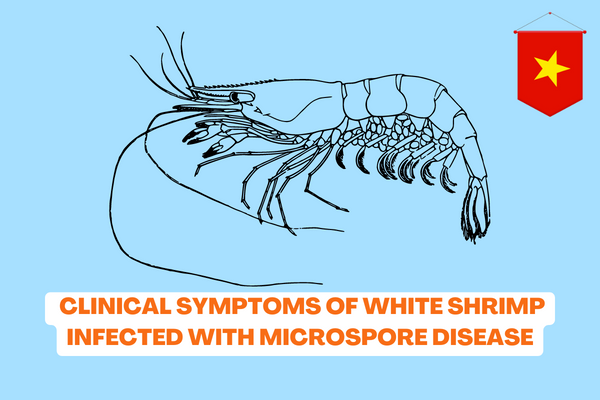Vietnam: What are the clinical symptoms of white shrimp infected with microspore disease? What is the cause of shrimp infection?
What are the clinical symptoms of white shrimp infected with microspore disease in Vietnam?
According to Section 5 of National Standard TCVN 8710-12:2019 on Aquatic Diseases - Diagnostic Procedures - Part 12: Enterocytozoon hepatopenaei microspore disease in shrimp, clinical symptoms in shrimp when infected with microspore disease are as follows:
"5 Clinical diagnosis
5.1 Epidemiology
The disease usually occurs on shrimp species of the he shrimp family (Penaeidae) such as black tiger shrimp (Penaeus monodon), he shrimp (P. merguensis), white shrimp (P. vannamei), brown shrimp (P. aztecus), P. setiferus ...
Some species can carry insects such as ground shrimp, crayfish, crabs, crabs, artemia zooplankton, Copepoda.
Shrimp are usually infected at a very early stage, from 10 days to 15 days after stocking and at the stages of cultured shrimp.
EHP can spread horizontally from diseased shrimp to healthy shrimp, indirectly from fresh feed to disease-carrying shrimp.
The disease can occur year-round and is distributed in the majority of shrimp farming regions in Asia-Pacific countries.
5.2 Clinical symptoms
Sick shrimp are poorly fed, sluggish, slow to grow, stunted, subcutaneous, and die scattered throughout the culture process.
When whiteleg shrimp infected with EHP are released in the first month, the shrimp still grow relatively normally, but after reaching a weight of about 3-4 g / head as well as the amount of biomass in the pond gradually increases, the shrimp begin to slow down and stop growth completely. Shrimp raised 90-100 days old also only reach a weight of 4-5 g / animal.
White or yellow-brown fecal filaments appear at or floating on the surface of the pond and cornering the pond or the end of the wind direction.
Hepatopancreas pale discoloration
5.3 Ticks
Shrimp with severe hepatopancreatic disease with necrosis (fluidization).
Shrimp have mild disease with unknown disease.
On histological slices showed the displacement of microspores in the tissue of the hepatopancreas mass."
According to the above standard, white shrimp when infected with microspore disease will have some clinical symptoms such as:
- Sick shrimp are poorly fed, sluggish, slow to grow, stunted, subcutaneous, and die scattered throughout the culture process.
- Shrimp grow slowly when reaching a weight of about 3-4g / animal.
- Shrimp raised 90-100 days old only reach a weight of 4-5 g / animal.
- White or yellow-brown fecal filaments appear at or above the pond surface and into the corner of the pond or at the end of the wind direction.

Vietnam: What are the clinical symptoms of white shrimp infected with microspore disease? What is the cause of shrimp infection?
What is the cause of white shrimp infected with microspore disease in Vietnam?
According to Section 1 and Section 2 of the National Standard TCVN 8710-12:2019 on Aquatic Diseases - Diagnostic Procedures - Part 12: Enterocytozoon hepatopenaei microspore disease in shrimp stipulates the causative agent of magnetic microcytosis in whiteleg shrimp as follows:
"1 Scope of application
This Standard prescribes the procedure for diagnosing Enterocytozoon hepatopenaei microspore disease in shrimp.
2 Terminology and definition
The following terminology and definitions are used in this standard:
Microsporidians are a group of intracellular parasitic microspores that includes Ameson, Agmasonma (Thelohania), Pleitophora, Enterocytozoon hepatopenaei.
Enterocytozoon hepatopenaei (EHP):
A parasite with a small size (about 1.1 x 0.7 μm) and a complex structure, there are 5-6 spirals with a fibrous structure at one end. EHP parasitizes in the hepatopancreas cells of shrimp using nutrition, energy reserves in the hepatopancreas, making farmed shrimp not nutritious enough to grow and molt."
Accordingly, the causative agent of microspore disease in whiteleg shrimp is enterocytozoon hepatorenal in shrimp.
Microspores are small parasites (about 1.1 x 0.7 μm) and complex in structure, with 5-6 spirals with a fibrous structure at one end. EHP parasitizes in the hepatopancreas cells of shrimp using nutrition, energy stored in the hepatopancreas, making farmed shrimp not nutritious enough to grow and molt.
What are some drugs and test materials commonly used when whiteleg shrimp are infected with microspore disease in Vietnam?
According to Section 3 of National Standard TCVN 8710-12:2019 on Aquatic Diseases - Diagnostic Procedures - Part 12: Enterocytozoon hepatopenaei microspore disease in shrimp, reagents and test materials used when shrimp are infected with microspore disease are as follows:
"3 Reagents and test materials
Use only analytical pure reagents, distilled water, demineralized water or water of equivalent purity, unless otherwise specified.
3.1 Reagents and shared reagents
3.1.1 Ethanol, from 96 % to 100 % (C2H6O)
3.1.2 Phosphate salt buffer (PBS)
3.2 Reagents and reagents for PCR and Realtime PCR diagnostics
3.2.1 Bait pairs, consisting of swept and reverse baits.
3.2.2 Bait pair, Probe
3.2.3 DNA extraction kits (See B1 and B2).
3.2.4 Kít nhân gen (PCR Master Mix Kit, Cat. No K0171).
3.2.5 Realtime PCR Genome Kit (Example: Kit Platinum® Quantitative PCR SuperMix-UDG, Cat.No: 11730-017).
3.2.6 TAE (Tris-brorate - EDTA) or TBE (Tris-acetate - EDTA) buffers (see A.1).
3.2.7 Dyes (Example: Sybr safe).
3.2.8 Loading dye 6X
3.2.9 TE buffer solution (Tris-acid ethylenenastetraaxetic).
3.2.10 DNA Ladder
3.2.11 Purified water, no nucleases
3.2.12 Agarose
3.3 Reagents and materials used for microscopic disease testing by HE staining method
3.3.1 Formalin, 10% solution (volume)
Prepared from a 38% solution of formaldehyde and a solution of phosphate buffered salts (PBS) or distilled water (volume ratio 1:9).
3.3.2. Xylene
3.3.3 Davidson's solution (see A.2).
3.3.4 Haematoxylin dyes (see A.3)
3.3.5 Eosin dyes (see A.4).
3.3.6 Paraffin, which has a melting point between 56 °C and 60 °C.
- 3.3.7 Laser glue
Thus, when whiteleg shrimp are infected with microspore disease, reagents and test materials according to the above standards will often be used to conduct disease diagnosis in the laboratory.
LawNet
